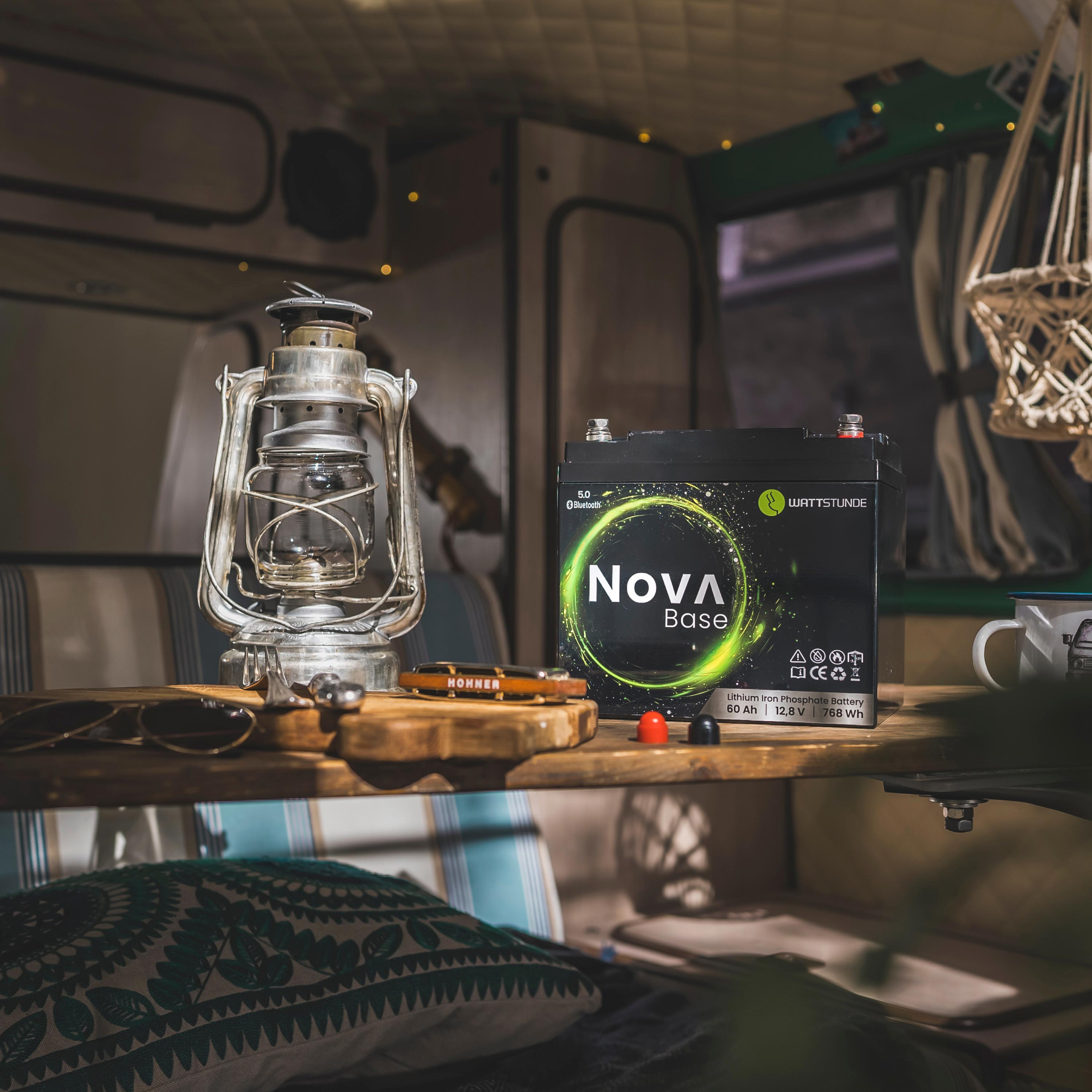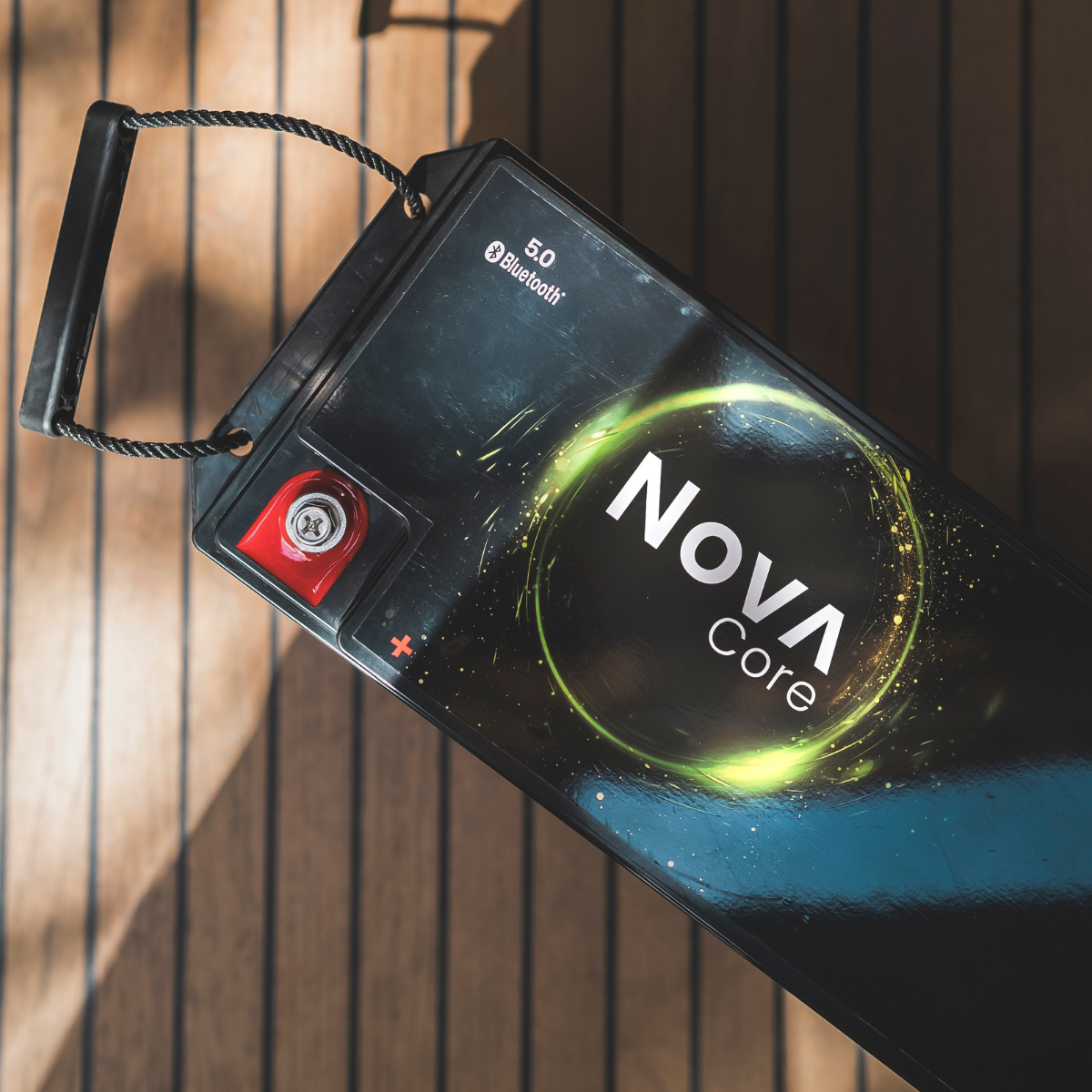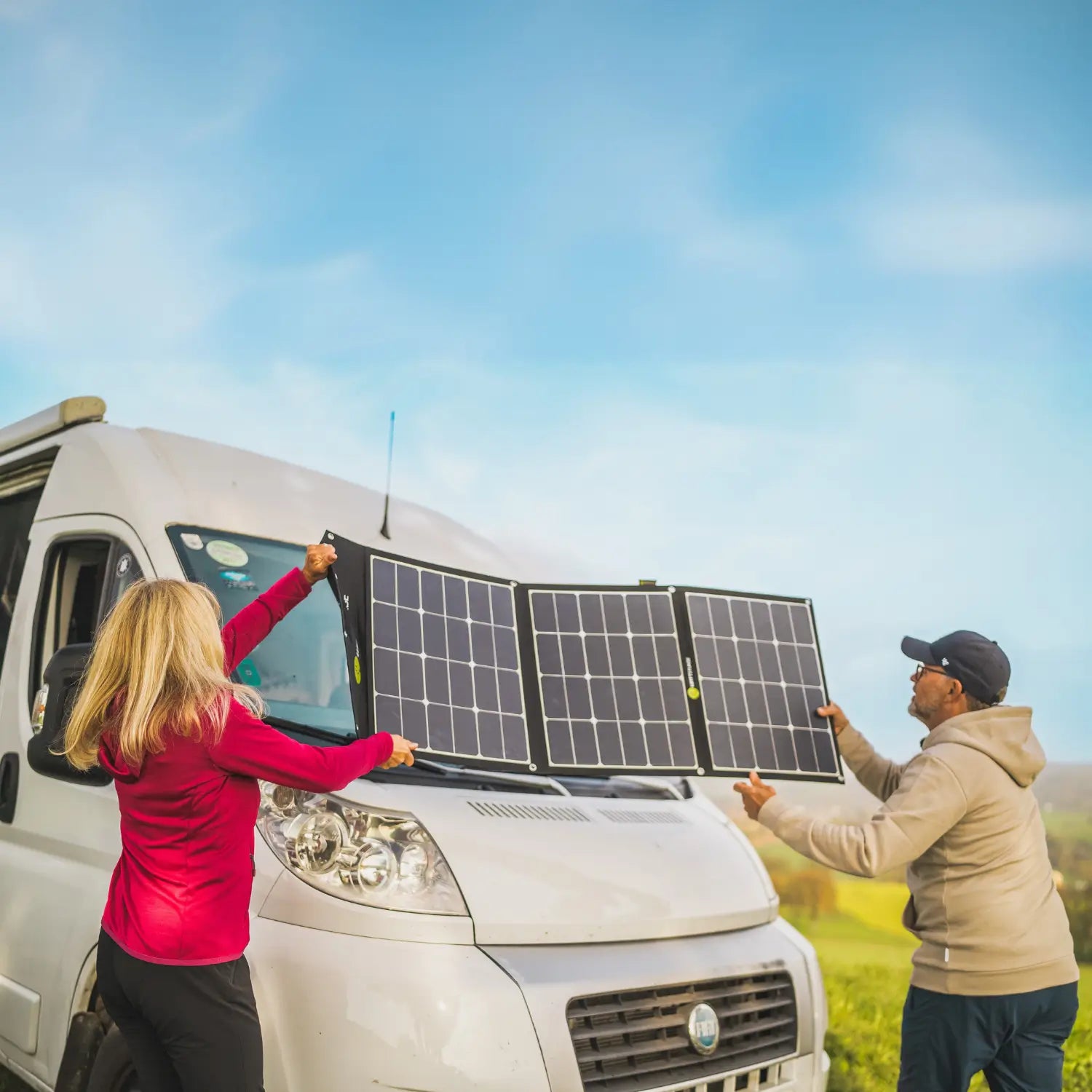Self-sufficient into the season is your 7-part blog series in which we tell you everything you need to know about the topic “Independent energy on the go” We'll guide you step by step through planning and optimizing your power supply so you can be independent of shore power while traveling, which leisure battery best suits your needs, and how to charge your battery even while driving.
Especially for those who travel frequently or want to camp far from campsites, a reliable power supply for their electronic devices is essential. What are the advantages of an independent power supply? How much power do different devices require? And what components are needed to equip your vehicle with an efficient, self-sufficient energy supply? You'll find all the answers in this first part.
Why self-sufficient power supply? - Independent travel with the right energy source
Anyone who travels a lot with a motorhome, campervan, or off-road vehicle knows how important a reliable power source is. An independent power supply allows you to travel without relying on campsites or external power sources – whether for a weekend in nature or an extended tour through remote regions. Instead of relying on expensive campsites with electrical hookups, you can organize your own energy supply with a clever combination of solar panels, a battery, and an inverter. If maximum security is your priority, you can rely on three pillars of energy supply: shore power when you're stationary at a campsite, a charging booster while driving, and solar panels when you want to operate your electronic devices away from the power grid.
Typical use cases for an independent power supply

-
Freestanding
If you like to camp away from the usual campsites, a reliable power supply is crucial. Refrigerator, lighting, water pump or laptop – all of these require energy. -
Longer journeys & van life
Many travelers spend weeks or months in their camper. A self-sufficient power supply ensures that you can be independent on the road – whether for mobile working, cooking with electronic devices, or charging camera batteries, smartphones, and your e-bike battery. -
Winter camping & year-round use
Especially during the cold months, a high-performance battery is essential to power heaters, fans, or other heat-related devices. -
Expeditions & Off-road Trips
Anyone traveling with an off-road vehicle needs a robust power supply for GPS devices, compressors, outdoor kitchens or emergency communication. -
Power supply on the boat
Sailors and boat owners also benefit from an independent energy source – be it for navigation instruments, lighting or cooling devices. -
More independence at home with a balcony power plant
Not only when you're on the go, but also at home, a partially self-sufficient energy supply can be advantageous. Balcony power plants allow you to reduce your electricity costs and become more independent from your electricity provider.
Which devices require electricity?
Before planning your self-sufficient energy system, you should carefully consider which devices will need power while you're on the go. Here's a detailed overview of the devices you might need:
-
Basic consumer goods – The minimum for self-sufficient travel
You will definitely need to include these devices in your plans to be able to use your vehicle independently:
Indoor and outdoor lighting: LEDs consume little energy but provide a pleasant atmosphere and safety at night.
Water pump: To ensure a constant flow of water for the sink, shower or toilet, the pressure or submersible pump requires a constant power supply.
Refrigerator/cooler: Thermoelectric coolers have high energy consumption, while compressor refrigerators are more efficient and can also be operated independently for several days.
Ventilation and heating: Diesel or gas heaters require electricity for the control system and the burner, as do fans to ensure air circulation in the summer. -
Comfort devices – For longer journeys and more amenities
If you use your vehicle more intensively or plan longer trips, additional electrical consumers are often added:
Laptop and mobile working: Those who work on the go need a stable power source for their laptop, monitor and mobile internet.
Coffee machine: Devices such as a Senseo or a small espresso machine draw high power and can only be used with sufficient battery capacity.
Induction hob: If you want to avoid using gas, you can also cook electrically with a powerful battery system and inverter.
Household appliances: Vacuum cleaners, blenders or toasters are also popular comfort enhancements in larger motorhomes.
Electric awning or pop-up roof: Some campers have electric awnings or pop-up roofs that require electricity for the motor. -
Safety & Outdoor Equipment – Essential for Off-Road and Expeditions
For adventurers and off-road enthusiasts, additional power consumers are important for being self-sufficient on the road:
Air compressor: Ideal for increasing tire pressure after an off-road tour.
Navigation devices & radios: GPS systems, CB radios or satellite phones must always be ready for use.
Wildlife cameras or surveillance systems: Some overlanders rely on security cameras or motion detectors around the vehicle.
Charging e-bikes & drones: Anyone who wants to charge their e-bike or camera equipment on the go needs a correspondingly powerful power supply. -
Medical devices – For a safe journey
Those who rely on certain devices for health reasons must also ensure a reliable power source while on the go:
CPAP devices for sleep apnea: A continuous power supply overnight is vital.
Medicine refrigerator: Some medications need to be kept refrigerated.
Here's how to calculate your consumption
Depending on the length of your trip and your comfort requirements, electricity consumption can vary significantly. Before deciding on a specific battery size or solar panel output, you should calculate your individual electricity consumption. The best way to do this is to create a list of all your appliances and how long you expect to use them each day. You can use the following formula as a guide:
Power (W) x Operating time (h) = Energy consumption per day (Wh)
Here is an example. Daily power consumption of LED lights, cooler and laptop:
- LED light (10W) for 5 hours → 50Wh
- Cooler box (50W) for 12 hours → 600Wh
- Laptop (60W) for 3 hours → 180Wh
The total consumption of these three consumers would then be: 830Wh per day
Based on this value, you can choose the appropriate battery size. A 100Ah lithium battery with a voltage of 12V (e.g., the The WATTSTUNDE NOVA Base 100Ah , for example, stores 1200Wh of energy – enough for daily needs with a reserve. Generally speaking: the The reserve buffer can be somewhat larger, at least 25%. You can find the power rating of your electronic devices on the device itself; it is given in "watts" and abbreviated as W.
Overview: These are the components you need for an independent energy supply
An efficient, self-sufficient power supply consists of Several key components need to be sized according to your individual energy requirements. If we assume a requirement of 830Wh per day, your energy setup should look like this:
-
Solar modules – The energy source for on the go
Solar panels convert solar energy into usable electricity, which is stored in a battery. Different types are available depending on the requirements:
- Framed solar panels: Ideal for permanent installations on motorhomes, vans or boats
- Flexible solar modules: Perfect for curved surfaces
- Foldable solar panels: Especially practical for mobile applications and shaded parking, as they are only used when needed.
- The required solar power depends on the amount of sunlight. In Central Europe, one can expect an average of... 3-5 hours of sunshine per day calculate. 120Wp A solar module produces a maximum of [amount] on a sunny day under optimal conditions. 480Wh (with 4 hours of sunshine).
- To generate 830Wh daily, you would therefore need at least 2x 120Wp Modules. Calculate here too. sufficient reserve If you're using 830Wh, you should also factor in a reserve of at least 207.5Wh.
-
Solar charge controller – The smart head of your solar system
The charge controller protects the battery from overcharging and ensures efficient charging. For a system with a daily consumption of 830Wh, an MPPT charge controller with a sufficiently high current rating is recommended, e.g., the Victron SmartSolar MPPT 75/15. -
Battery – Your efficient energy storage
The battery is the heart of your solar power system. The energy that your solar panels generate during the day can be stored in the battery to provide electricity at night or on cloudy days.
A 100Ah 12V lithium battery (e.g. The WATTSTUNDE NOVA Core 100Ah battery delivers approximately 1280Wh of usable capacity – enough to be self-sufficient for about 1.5 days. Remember to factor in a sufficient reserve. -
Inverter – 230V for household appliances
If you want to operate devices with 230V, you need an inverter that converts the 12V DC from the battery into AC. For smaller devices like laptops or coffee machines, which don't consume quite as much power, a 1000W inverter is sufficient.
For energy-intensive appliances such as induction hobs or kettles, you need at least 2000-3000W. -
Cables, fuses & accessories – For a safe installation
In addition to the main components, high-quality cables and fuses are necessary to ensure a safe power supply, including MC4-compatible extension cables for a secure connection between the solar module and charge controller, battery cables and fuses for stable power distribution, and solar module mounts for robust installation on vehicles or roofs. -
Charging booster as an additional power source while driving
A charging booster ensures optimized and efficient charging of the vehicle's battery while driving. It raises the charging voltage to the optimal level, allowing the battery – especially modern lithium or AGM batteries – to be charged faster and more completely. Particularly in Euro 6 vehicles with intelligent alternators, the charging booster prevents insufficient charging of the vehicle's battery. This ensures a reliable power supply in campers or off-road vehicles, even on short journeys.
Conclusion
With the right combination of solar panels, battery storage, charge controller, and inverter, your vehicle can be perfectly prepared for independent travel. If you You know your energy needs and the By choosing the right components , you can rely on a stable power supply even far from campsites. This makes long journeys even more enjoyable. maximum independence And nothing stands in the way of comfort!
Here's what you can expect in the upcoming blog post
Stay tuned – in the next six parts In our blog series, we'll go into more detail. We'll show you, Which battery type? suits you which charging technologies there are and how you can install your solar system You've wired it correctly . In the second part, which will be published next week, we'll compare different battery types for you (lifespan, charging cycles and maintenance) and discuss with you how many Ah you need.
Independent of shore power! In our blog series, you'll learn what components you need for your self-sufficient energy supply!









